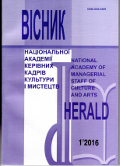МУЗЫКАЛЬНЫЙ НЕОКЛАССИЦИЗМ В ИСПОЛНИТЕЛЬСКОМ ИСКУССТВЕ
Neoclassicism in music performance
Author(s): Mariia RiabokonevaSubject(s): Music, Cultural Anthropology / Ethnology
Published by: Національна академія керівних кадрів культури і мистецтв
Keywords: neoclassicism in music; neo-classical situation; objective type of performance;
Summary/Abstract: Neoclassicism in music is a very complex stylistic phenomenon. Scientific and artistic discussions do not cease to rage around it until this day. The vast amount of research has centered around neoclassical composers’ oeuvre bypassing performing and pedagogical activities which are equally important and closely related to art of composition.The most important prerequisite for the XX century Neoclassicism in music was the emergence of the concept of "classical music" with its canon based on the works of the "classical" period, which was associated with the names of Haydn, Mozart and Beethoven. In the era of romanticism a phenomenon of simultaneous coexistence of different historical styles appeared in the musical practice. Absolutization of the idea of individual personal expression accelerated the process of permanent renewal of means of expression and put greater distance between the past and the modern (romantic) in music. In the constant search for the new many composers of late Romanticism drew inspiration from the idealized "classical", thus creating a situation of simultaneous deliberate coexistence of different historical stylistic components within the same piece of music.In concert halls such a situation manifested itself in the neighborhood of works by contemporary authors and works of the old masters within one program. The increasingly visible presence in various fields of musical activity of idealized "classical" competing in its impact on the audience with an individualized "modern" led to the splitting of the XIXth century music performance in two trends – more individualized and more idealized. The most important factor which helped such stylistic disengagement was a gradual separation of the two (until the second half of the XIXth century inextricably welded) incarnations of a professional musician – composer and performer. Artists were focused not only on matters of expression, virtuosity, transcendence of performance but also on the problems of the correct rendition of the author’s text, stylistic congruity, interpretive freedom, expanding the repertoire with hitherto little-known works of the past.
Journal: Вісник Національної академії керівних кадрів культури і мистецтв
- Issue Year: 2016
- Issue No: 1
- Page Range: 48-53
- Page Count: 6
- Language: Russian

